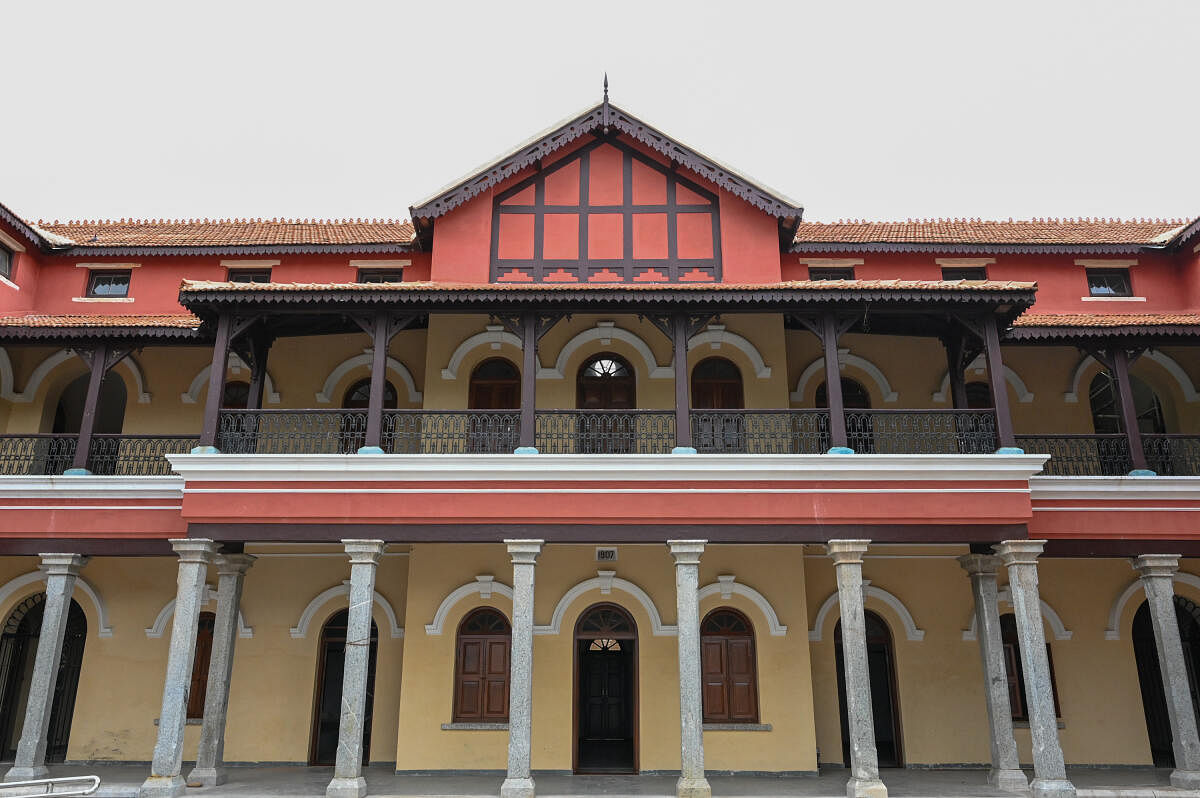

Driving down K R Road from south Bengaluru towards the City Market, not long after you leave the National College grounds behind you, you see a red building in the distance. At first, only the gable roofs are visible. Then, as the road rises just a little, the whole handsome structure of Fort High School is revealed.
From the end of March, hundreds of music lovers have been heading to the vast grounds of Fort High School to participate in one of the most important cultural events in the calendar — the annual music festival organised by the Sree Ramaseva Mandali. The Mandali has been organising this since 1939, but it was only in the late 1960s that the event moved to the Fort High School grounds.
The Mandali erects a temporary stage and a huge pandal every year for the event. The orientation of the stage and pandal means that the majority of the more than 10,000 people who attend the concerts at Fort High School do not see the school building itself. This is unfortunate because the school and the building are exceptional in several ways.
The school’s origins go back to when Bengaluru was a divided city. The cantonment areas formed the Civil & Military Station, which was administered by British India. The rest of the city was under the Maharaja’s administration.
In the late 1800s, a City Municipal English School was established in the old fort area. When the plague struck in 1898, this school for boys was temporarily moved to Tipu’s Palace, which then also housed a Kannada school. In 1899, the government set aside the current site for a new building to house the Kannada school.
However, when construction was completed in 1907, residents of Chamarajapete and the new suburb of Basavanagudi requested that the premises be given over to the English school. In the early 1900s, there were no modern schools in the newly-established neighbourhoods, and the many private English-medium schools in the cantonment areas were inaccessible to most Indians.
Accordingly, the City Municipal English School moved to the new building. This was later renamed the Government Anglo-Vernacular School and later still, renamed Fort High School. Today, it is a co-educational and is one of the Karnataka Public Schools.
The restoration
In the last few decades, poor maintenance had taken a toll on the structure. In 2018, the Indian National Trust for Art and Cultural Heritage (INTACH) decided to restore this significant landmark to its original glory. With permission from the government and financial support from the Bengaluru-based Mineral Enterprises Limited, INTACH Bengaluru Chapter completed the restoration in December 2020.
Our work on the structure led to many discoveries. When it was first built, the school was a simple, symmetrical structure with a stone pillar colonnade on either side of a large, central hall. In the late 1920s, a U-shaped addition was added on the northern side, thereby forming a courtyard, which is one of the attractive features of the building. The character of this brick-and-lime mortar building is further enhanced by the wooden colonnade on the first floor. There are also period decorative features such as arched mouldings and stucco motifs on the parapets.
Some design details are not seen anywhere else in Bengaluru, for example, the very ornamental, corbelled masonry brackets that support the first-floor corner projections. Also uniquely designed are the gable walls of the main façade. These walls are defined with large windows and a composite wall construction of a timber framework with brick infill, rather like in Tudor architecture.
We found a few construction details that make Fort High School technologically significant too. On the first floor, some rooms have a particular kind of composite truss called the ‘Polonceau truss’. In this building, these trusses of metal and wood were made with materials brought from Europe. To our knowledge, they are the earliest trusses of this particular kind in Bengaluru.
One striking difference since our project that even passersby would have noticed is the restoration of the original red colour. The project also improved basic amenities, such as toilets and spaces for midday meals by modifying some modern annexe buildings and integrating them with the heritage building.
As World Heritage Day approaches, Fort High School reminds us of how besides being repositories of memories, buildings can be culturally, architecturally, historically and technologically significant.
(Meera Iyer is the author of ‘Discovering Bengaluru’ and the Convenor of INTACH Bengaluru Chapter.)